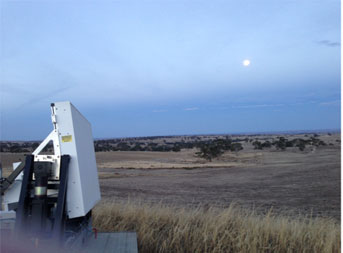Phased Array Weather Radar Deployed Down Under for Fighting Bushfires
Outcome/accomplishment:
Researchers at the NSF-funded Engineering Research Center (ERC) for Collaborative Adaptive Sensing of the Atmosphere (CASA) have successfully deployed a phased array weather radar to South Australia. Field trails are being conducted in collaboration with Australian researchers to demonstrate the radar's ability to map the file-scale structure of the wind field surrounding bush fires to support firefighting.
Impact/benefits:
Wildfires ravage millions of acres each year. Fighting these fires is hampered by sudden wind shifts which can fan flames and cause fire lines to change direction unexpectedly. Small phased array radars have the potential to map these wind shifts and provide critical information to firefighters and evacuation planners during the course of wildfire events. CASA researchers from the University of Massachusetts, Amherst (UMass) have teamed with Australian investigators to study this problem in South Australia where conditions mimic the situation in many parts of the United States. Successful export of phased array weather radar technology to Australia also sets the stage for similar deployments at different countries around the globe, where phased array radars can be used to map fires, tornadoes, storms, and other atmospheric and airborne hazards.
Explanation/Background:
The CASA ERC is advancing the concept of dense networks of small radars that can be deployed on rooftops and communication towers for fine-scale mapping of winds and rain in the lower atmosphere. Such networks do not suffer earth curvature blockage and other fundamental limitations of today's large Doppler weather radars. Phased array antennas are a key enabling technology for these deployments since they lack moving parts and do not need costly maintenance the way mechanically-scanned radars do. CASA has approached the issues of affordability and exportability of phased arrays by using low-power and commonly-available microwave integrated circuits to design antennas that electronically steer their beams without requiring motors. The goal of this project is to determine the degree to which low-power phased array radars can map the wind fields surrounding a wildfire. This is a challenging problem when the atmosphere is contaminated by smoke and lofted debris and the particulates move in multiple directions. This problem is being studied in collaboration between the University of Massachusetts, Amherst, Raytheon Company, and an Australian team comprised of participants from the University of Adelaide, University of Melbourne, the Australian Bureau of Meteorology, the Australian Defense Science and Technology Organization, and Raytheon Australia. This is the first deployment of CASA's phased array radar outside of the laboratory setting. This successful deployment to Australia thus represents an important milestone not only in development of the phased array radar itself, but also in having successfully exported the technology overseas.

|